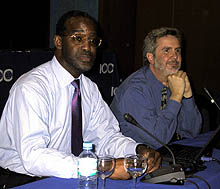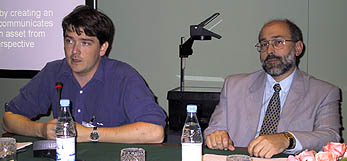|
|
|||||||||||||||||||||||||||||||||||||||||
|
|||||||||||||||||||||||||||||||||||||||||
|
Events convened on Friday, 9 November 2001 |
|
Why does business need a carbon rating engine: A new business
initiative for early greenhouse gas trading
Presented by the International Emissions Trading Association
The Carbon Repository concept was elaborated to facilitate the early development of trading by providing a clearer link between what is being traded today and the meeting of future emissions limitations when regulatory frameworks are established within different jurisdictions. The Repository was aimed to address: the absence of rules to allow cross-border and cross-jurisdiction trading; uncertainties associated with the quality of credits that can be obtained; risks associated with undertaking early investments in emissions reductions before rules are finalized and with the lack of certainty that valid credits will be generated; and the ability of entities to trade emission credits to offset future GHG emissions liabilities with the knowledge that they will be valid as compliance units. Joshua explained that the Repository would work by taking in verified emissions reduction units from different types of projects, evaluating their quality by applying various risk management techniques and determining their value in terms of a common carbon credit, and issuing guaranteed "gold standard" carbon securities. Joshua explained that the study found that a carbon repository is technically feasible, but requires certain preconditions which do not yet exist, including: the design and implementation of a Carbon Rating Engine (a software tool that could assess the value of a ton of reduction and the rate of risks); the development of a market risk model that can forecast the future price of carbon; the emergence of insurance products; and greater clarity on regulatory frameworks. Dirk Forrister, Natsource, announced that, following the successful completion of the feasibility study, the EMDG has decided to move forward with an initiative to work toward the eventual commercial launch of the Carbon Respository concept. The EMDG has commenced a pilot programme, whose goals are to: enhance the value of intellectual property; develop and test tools; be prepared to capitalize on market opportunities; and take advantage of shared learning, shared costs, and diversity in expertise. The pilot programme is working to develop a carbon rating engine, a trading platform, a registry, a pilot carbon portfolio, more carbon prices, and insurance products.
|
|
CDM projects and industry: Baselines and additionality assessment Presented by UNIDO in collaboration with Mitsubishi Research Institute (MRI)
Samy Hotimsky, Environmental Resources Management Group, described the application of the UNIDO guidelines to industrial projects in the Brazilian private sector. He presented findings of a multi-stakeholder workshop, "Capacity Building for CDM Projects in Industry," which served as a forum for project developers to share their experiences. The workshop discussed, inter alia, standardizing procedures for baseline development. One conclusion from the workshop was that a large information gap still exists between the Brazilian private sector and public institutions in charge of the CDM. The results of the workshop indicate that the elaboration of technical issues is crucial, and that rules for baseline development should be carried out via public-private dialogue. Tadashi Aoyagi, MRI, explained that it will be difficult for Japan to meet its emissions reduction commitments under the Kyoto Protocol because the country is already highly energy efficient compared to other OECD countries, and because the cost of emissions reductions is high. He highlighted that the Japanese Government intends to submit a bill to ratify the Kyoto Protocol in the next parliamentary session, and that this will increase Japanese industries' interest in joint implementation (JI) and the CDM. Aoyagi described an MRI initiative to evaluate commercially viable projects that result in emissions reductions, explore business opportunities to expand credit trading, and eventually set up a pilot system to assess trading. Kan Araki, Natsource Japan, described the Japan Emission Management Simulation (JEMS), a virtual emissions trading system that involved over 30 participants from various industries. The objectives of the JEMS were to: accustom industries to emissions trading; analyze the cost-effectiveness of emissions reduction; and assess corporate decision making on GHG reduction measures. Araki noted that there will be a second JEMS project and that anyone interested in participating should contact MRI or Natsource Japan.
|
|
For
further RealVideo coverage of these and other side-events at COP-7,
please visit the UNFCCC's "On Demand" webcast page |
|
| The Earth Negotiations Bulletin (ENB) on the side is a special publication of the International Institute for Sustainable Development (IISD) in cooperation with the United Nations Framework Convention on Climate Change (UNFCCC) Secretariat. The Editor of ENB on the side is Kira Schmidt <kira@iisd.org>. This issue has been written by Fiona Koza <fiona@iisd.org>, Dagmar Lohan <dagmar@iisd.org>, and Kira Schmidt <kira@iisd.org>. The Digital Editors are Andrei Henry <andrei@iisd.org>, Leila Mead <leila@iisd.org> and Kenneth Tong <ken@iisd.org>. Funding for publication of ENB on the side at COP-7 is provided by the UNFCCC Secretariat. The opinions expressed in ENB on the side are those of the authors and do not necessarily reflect the views of IISD and funders. Excerpts from ENB on the side may be used in non-commercial publications only and only with appropriate academic citation. For permission to use this material in commercial publications, contact the Managing Editor at <kimo@iisd.org>. Electronic versions of these issues of ENB on the side from COP-6 Part II can be found on the Linkages WWW server at http://enb.iisd.org/climate/cop7/enbots/. | |
|
|
| © 2001, IISD. All rights reserved. |
|




